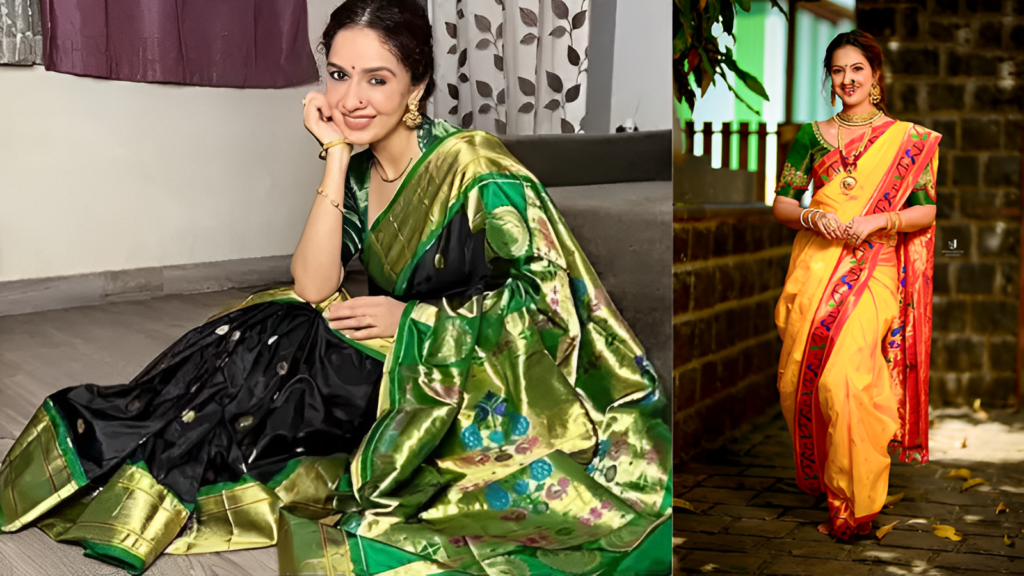The exquisite traditional sarees of Maharashtra have made the land of diversity and rich cultural heritage more meaningful. Maharashtrian sarees carry a unique charm, with a distinct origin, fabric choice, and draping styles. In this blog, we will delve into the enchanting world of Maharashtrian sarees. We will explore their origin, fabric types, and occasions on which women wear them.
Join us on this journey as we unravel the beauty and diversity of Maharashtrian sarees and it’s traditions.
Paithani Saree: A Jewel of Maharashtra

The Paithani saree is indeed a jewel of Maharashtra and is renowned for its exquisite craftsmanship and rich heritage. It is a traditional handwoven silk saree that originated in the town of Paithan in Maharashtra, India. Paithani sarees are highly regarded for their intricate motifs, vibrant colors, and luxurious texture.
Here are some key features and aspects of Paithani sarees:
- Handwoven Silk: Typically, artisans make Paithani sarees from pure silk, which gives them a lustrous and regal appearance.
- Motifs and Designs: One of the distinguishing features of Paithani sarees is their elaborate and detailed motifs. These motifs often depict peacocks, lotus, parrots, and other elements inspired by nature.
- Pallu and Borders: The pallu and borders of Paithani sarees are usually the most elaborate part, showcasing elaborate peacock motifs or other traditional patterns.
- Color Combinations: People know Paithani sarees for their striking color combinations.. The color palette includes vibrant shades like royal blue, emerald green, deep purple, maroon, and gold.
- Traditional Weaving Techniques: Skilled artisans employ traditional handloom weaving techniques, often incorporating gold or silver threads (zari) for added opulence.
- Tapestry Technique: Artisans use the tapestry technique known as “Kadiyal” to create vibrant and textured patterns.
- Types of Paithani sarees: There are primarily two types of Paithani sarees, Traditional Paithani and Brocade Paithani. Both types of Paithani sarees exemplify the artistry and cultural heritage of Maharashtra, captivating the admirers of traditional handwoven silk sarees.
- Artisanal Craftsmanship: Each Paithani saree is a masterpiece of artistry, involving the collective effort of weavers, dyers, and designers.
The Maharashtrian people hold the Paithani saree in a special place in their hearts and cherish it as a cultural treasure. It represents the elegance, beauty, and artistic traditions of Maharashtra, making it a truly valuable and timeless garment.
Kolhapuri Saree: Embodiment of Elegance
The Kolhapuri saree is a true embodiment of elegance, hailing from the city of Kolhapur in Maharashtra, India. It is a handcrafted masterpiece that showcases the rich cultural heritage of the region.
Here are some key features of Kolhapuri sarees:
- Intricate Hand Block Printing: These sarees are known for their exquisite hand block printing techniques. Skilled artisans create intricate patterns using wooden blocks dipped in natural dyes. These prints often feature motifs inspired by nature, geometric designs, and traditional patterns.
- Fine Cotton and Silk Fabrics: These sarees gain recognition for their exquisite hand block printing techniques.
- Vibrant Color Palette: Kolhapuri sarees boast a bold and vibrant color range, creating a striking visual impact.
- Zari and Embroidery Work: To enhance beauty and elegance, Kolhapuri sarees often feature intricate zari work (gold or silver thread embroidery) on the borders, pallu, and motifs.
- Pallu with Unique Designs: The pallu of a Kolhapuri saree is a standout feature. Elaborate designs and motifs adorn the Paithani saree, often showcasing peacocks, flowers, or traditional patterns. Artisans meticulously craft the pallu to make a style statement.
- Cultural Significance: These sarees hold cultural significance, representing the artistry and heritage of Maharashtra.
Kolhapuri sarees are a perfect blend of traditional craftsmanship and modern aesthetics, making them a captivating choice for any occasion.
Narayan Pethi Saree: Timeless Traditional Charm

Narayan Pethi saree is a testament to timeless traditional charm, originating from the city of Pune in Maharashtra, India. This handwoven masterpiece showcases the rich cultural heritage and artistic craftsmanship of the region.
Here are some key features of Narayan Pethi sarees:
- Pure Silk Elegance: Artisans meticulously weave Narayan Pethi sarees from pure silk, adding a touch of opulence and elegance to the fabric.
- Rich Zari Borders: Artisans adorn the saree with intricate zari borders, featuring elaborate patterns and motifs. The golden or silver threads used in the zari work enhance the grandeur of the saree.
- Traditional Designs and Motifs: Narayan Pethi sarees often feature traditional designs and motifs inspired by nature, such as flowers, peacocks, and paisleys. These intricate patterns are woven with precision and attention to detail.
- Paithani Influences: Narayan Pethi sarees draw inspiration from the Paithani saree tradition, incorporating elements like peacock motifs, interwoven designs, and vibrant color combinations.
- Striking Color Palette: These sarees showcase a wide range of vibrant colors, including royal blue, maroon, emerald green, and gold. The color combinations are carefully chosen to create a captivating visual impact.
- Pallu Splendor: The pallu of a Narayan Pethi saree is a focal point, adorned with elaborate designs, motifs, and zari work. It often displays intricate peacock or floral patterns, adding to its traditional charm.
- Handcrafted Beauty: Each Narayan Pethi saree is a labor of love, crafted by skilled artisans who meticulously weave the fabric and incorporate intricate details.
Narayan Pethi sarees encapsulate the essence of timeless traditional charm, making them a treasured addition to any wardrobe. Experience the allure of Narayan Pethi sarees and embrace the timeless beauty they embody.
Nagpur Saree: Classic Elegance
Nagpur saree is renowned for its classic elegance, originating from Nagpur, a city in Maharashtra, India. These sarees embody timeless beauty and sophistication, making them a favorite among saree enthusiasts.
Here are the key features of Nagpur sarees:
- Fine Fabric: Artisans craft Nagpur sarees from fine fabrics such as silk or cotton, ensuring a luxurious feel and graceful drape. The choice of fabric contributes to the overall elegance of the saree.
- Subtle Color Palette: Nagpur sarees often feature a subtle and sophisticated color palette. Soft pastel shades, earthy tones, and muted hues commonly adorn Nagpur sarees, adding a touch of understated elegance.
- Minimalistic Design: These sarees are known for their minimalistic yet impactful design elements. They often feature delicate borders, subtle motifs, and intricate patterns that enhance the overall grace of the saree.
- Zari and Thread Work: Nagpur sarees may incorporate zari (gold or silver thread) work on the borders or pallu, adding a touch of glamour and sophistication. The thread work is done with precision and adds a subtle richness to the saree.
- Traditional Craftsmanship: Nagpur sarees are a result of skilled craftsmanship and attention to detail. The weavers meticulously create these sarees, ensuring every element is intricately woven and aligned, showcasing their artistry.
Nagpur sarees exude classic elegance, making a statement with their understated beauty and refined craftsmanship. Whether worn for special occasions or daily wear, they embody grace and sophistication, truly standing the test of time.
Solapuri Saree: Handcrafted Beauty

Solapuri saree, also known as Solapur saree, is a traditional handloom saree that originates from Solapur, a city in Maharashtra, India. These sarees gain renown for their unique weaving techniques and distinctive features.
Here are some key aspects of Solapur sarees:
- Cotton Fabric: Weavers predominantly weave Solapuri sarees from pure cotton, making them lightweight, breathable, and ideal for warm weather.
- Colorful Borders: Artisans characterise these sarees by intricately weaving vibrant and contrasting borders. The borders often feature geometric patterns, stripes, or traditional motifs.
- Traditional Motifs and Designs: Solapuri sarees showcase a range of traditional motifs and designs inspired by nature, such as peacocks, flowers, leaves, and paisleys. Artisans weave these motifs into the fabric using vibrant colors.
- Khadi Weaving: Weavers typically weave Solapuri sarees using the khadi weaving technique, which involves hand-spinning the cotton yarn and weaving it on a handloom. This technique adds a unique texture and charm to the sarees.
- Pallu Embellishments: The pallu (the loose end of the saree) of a Solapuri saree often features intricate designs and motifs, sometimes with additional embellishments like zari work or embroidery.
- Durability and Longevity: People know Solapuri sarees for their durability and longevity. With proper care, they can last for many years, making them a cherished possession.
Solapuri sarees epitomize the beauty of traditional handloom weaving and showcase the rich cultural heritage of Maharashtra. Their vibrant colors, intricate designs, and comfort make them a popular choice among saree lovers, reflecting the artistry and craftsmanship of the weavers.
To explore the diverse styles of sarees across different states and embrace the cultural richness of India’s textile heritage. Click Here
Conclusion
Maharashtrian sarees, including the Paithani, Kolhapuri, Narayan Pethi, Sholapuri, and Nagpur saree, represent Maharashtra’s rich textile heritage. These Maharashtrian Sarees are a symbol of cultural legacy and craftsmanship. They showcase a variety of fabrics, designs, and colors, adding grace to special occasions and everyday wear. Maharashtrian sarees hold great pride and serve as a connection to the state’s diverse traditions. They embody unity in diversity and are a source of identity for Maharashtrian women. By preserving and promoting these sarees, we ensure the heritage lives on for generations to come.


